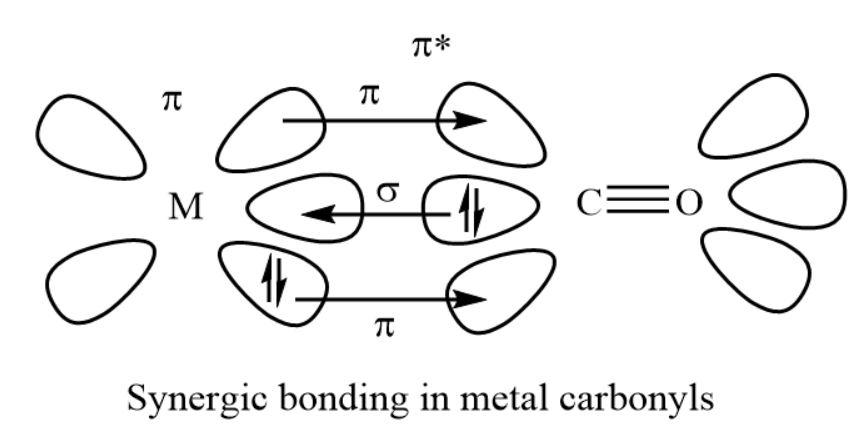
Discuss the nature of bonding in metal carbonyls.
Answer
492.3k+ views
Hint:
We know that the metal carbonyls are the compound in which coordination complexes are formed and the transition metals combine with the carbon monoxide (CO). They are organometallic compounds.
Complete step by step solution
As we all know, the metal carbonyl bond is the bond between the metal and the carbon. This bond shows both the sigma and pi characters. A sigma bond generally is made when the carbonyl carbon present in the complex gives an electrons’ lone pairs to the unoccupied orbital of the given metal. A pi bond usually made by the donation or contribution of an electrons’ pair from the occupied metal.
Metal carbonyls show the two types of bonding.
- The formation of sigma bond from carbonyl to metal that is (
- The formation of pi bond from metal to carbonyl that is (
- The back bonding produces a synergic effect and it makes stronger the bond between carbonyl and the metal.

Note:
The use of metal carbonyls is written below.
- The metal carbonyls are used as the catalyst in the synthesis of other chemical species.
- The metal carbonyls are used in the chemistry laboratory.
We know that the metal carbonyls are the compound in which coordination complexes are formed and the transition metals combine with the carbon monoxide (CO). They are organometallic compounds.
Complete step by step solution
As we all know, the metal carbonyl bond is the bond between the metal and the carbon. This bond shows both the sigma and pi characters. A sigma bond generally is made when the carbonyl carbon present in the complex gives an electrons’ lone pairs to the unoccupied orbital of the given metal. A pi bond usually made by the donation or contribution of an electrons’ pair from the occupied metal.
Metal carbonyls show the two types of bonding.
- The formation of sigma bond from carbonyl to metal that is (
- The formation of pi bond from metal to carbonyl that is (
- The back bonding produces a synergic effect and it makes stronger the bond between carbonyl and the metal.

Note:
The use of metal carbonyls is written below.
- The metal carbonyls are used as the catalyst in the synthesis of other chemical species.
- The metal carbonyls are used in the chemistry laboratory.
Recently Updated Pages
Master Class 9 General Knowledge: Engaging Questions & Answers for Success

Master Class 9 English: Engaging Questions & Answers for Success

Master Class 9 Science: Engaging Questions & Answers for Success

Master Class 9 Social Science: Engaging Questions & Answers for Success

Master Class 9 Maths: Engaging Questions & Answers for Success

Class 9 Question and Answer - Your Ultimate Solutions Guide

Trending doubts
Give 10 examples of unisexual and bisexual flowers

Draw a labelled sketch of the human eye class 12 physics CBSE

Differentiate between homogeneous and heterogeneous class 12 chemistry CBSE

Differentiate between insitu conservation and exsitu class 12 biology CBSE

What are the major means of transport Explain each class 12 social science CBSE

What is the difference between resemblance and sem class 12 social science CBSE




